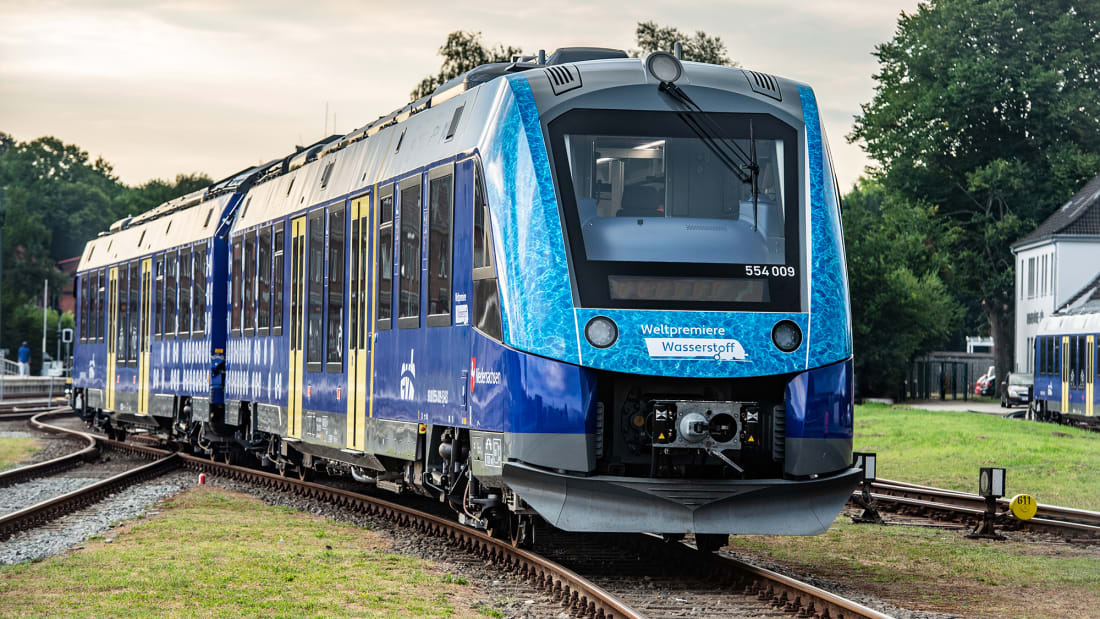|
|
|
eightonedee
|
 |
« Reply #76 on: June 01, 2022, 17:56:46 » |
|
Here's something that I have just spotted on Youtube- https://www.youtube.com/watch?v=ch0w71ovxbMI cannot see this happening here, and you will see that it's not available on high speed services, and there are concerns at how funding this will affect the finances of participating transport undertakers mentioned towards the end. But with a somewhat higher price (and no threat of industrial action) perhaps something to contemplate for the summer months? |
|
|
|
|
 Logged
Logged
|
|
|
|
|
broadgage
|
 |
« Reply #77 on: June 03, 2022, 17:55:31 » |
|
News reports state 4 lives lost and many injured, some are in a serious condition. https://www.bbc.co.uk/news/world-europe-61684048 |
|
|
|
|
 Logged
Logged
|
A proper intercity train has a minimum of 8 coaches, gangwayed throughout, with first at one end, and a full sized buffet car between first and standard.
It has space for cycles, surfboards,luggage etc.
A 5 car DMU▸ is not a proper inter-city train. The 5+5 and 9 car DMUs are almost as bad.
|
|
|
|
broadgage
|
 |
« Reply #78 on: June 03, 2022, 18:03:46 » |
|
Local reports state no obvious cause for this accident. Video from the scene shows all or most vehicles to be de railed, with some a significant distance from the track.
No other train involved, fine weather.
Fortunately the scene is near a main road, which has speeded access by emergency services. Some UNCONFIRMED Reports suggest 6 lives lost.
The bereaved and injured are no doubt in our thoughts.
|
|
|
|
|
 Logged
Logged
|
A proper intercity train has a minimum of 8 coaches, gangwayed throughout, with first at one end, and a full sized buffet car between first and standard.
It has space for cycles, surfboards,luggage etc.
A 5 car DMU▸ is not a proper inter-city train. The 5+5 and 9 car DMUs are almost as bad.
|
|
|
|
stuving
|
 |
« Reply #79 on: June 04, 2022, 23:47:12 » |
|
An update from Metro: Emergency workers found another body under the rubble of a train that derailed in southern Germany on Friday, bringing the total number of deaths to five.
Rescuers continued looking for survivors this morning following the disaster in the picturesque mountainous region north of Garmisch-Partenkirchen in Bavaria.
A regional train travelling from the Alpine ski resort to Munich spun off the tracks, causing at least three carriages to overturn.
Authorities said five people are confirmed dead and 44 are hurt, including three passengers who are being treated in hospital for serious injuries.
A police spokesperson said a major operation to free people from the wreckage had been completed.
‘As far as we can tell, all the people have been rescued from the train,’ the spokesperson said, adding that removing the overturned wagons would ‘certainly take a few days.’
On Saturday, however, Bavarian Interior Minister Joachim Herrmann said it was possible that there could still be bodies trapped underneath the rubble, saying some seven people were still unaccounted for.
Around 140 people were on board when the accident happened.
After several failed attempts, cranes succeeded on Saturday in hoisting at least one carriage of the train which had rolled off the tracks.
Prosecutors have launched an investigation into the cause of the incident... |
|
|
|
|
 Logged
Logged
|
|
|
|
|
|
|
infoman
|
 |
« Reply #81 on: August 25, 2022, 06:13:58 » |
|
From 1 October to 7 April, N95-type face masks will be required during all long-distance travel by trains, buses and planes.
|
|
|
|
|
 Logged
Logged
|
|
|
|
|
stuving
|
 |
« Reply #82 on: August 25, 2022, 09:06:21 » |
|
Here's a more accessible report of this; from New Civil Engineer: German railway company Deutsche Bahn (DB» ) is set to complete an inspection of concrete sleepers in its rail network by the end of the month.
DB experts have been testing around 200,000 sleepers across the country since July, with repairs expected to cost several hundred million euros.
The work is being carried out as a precaution following an accident near Garmisch-Partenkirchen on 3 June. Five people were killed and 68 injured when a regional train derailed on the Garmisch-Partenkirchen - Oberau line in southern Germany.
Although the investigations into the accident have not yet been completed, DB has decided to investigate sleepers across the network. The first preliminary findings from technical reports by independent testing institutes now suggest that there is a manufacturer error. Sleepers are typically spaced about 0.7 m apart, so this affects less than 150 km of track in all - though that could be in short stretches spread over the wider network. It all proves there's nothing so boring and simple it doesn't need to be designed and made right to avoid disasters (see also under "earthworks"). |
|
|
|
|
 Logged
Logged
|
|
|
|
|
Worcester_Passenger
|
 |
« Reply #83 on: August 25, 2022, 10:50:01 » |
|
I'm grateful for the advance warning on this. I was supposed to be travelling from Munich to Paris next month, with a seven-minute connection in Stuttgart (the German booking computer says it's OK). But I'm now taking an earlier train with a longer connection! |
|
|
|
|
 Logged
Logged
|
|
|
|
|
CyclingSid
|
 |
« Reply #84 on: August 26, 2022, 06:51:11 » |
|
spun off the tracks I can understand a car spinning off the road due to ice or water, but how does a train spin of the tracks? Or just more journalese? |
|
|
|
|
 Logged
Logged
|
|
|
|
TonyK
Global Moderator
Hero Member
    
Posts: 6638
The artist formerly known as Four Track, Now!

|
 |
« Reply #85 on: August 26, 2022, 08:34:16 » |
|
Germany has introduced its first hydrogen powered passenger rail services, according to CNN and others. The world's first hydrogen-powered passenger trains are hereJulia Buckley, CNN • Updated 24th August 2022  (CNN) — The future of environmentally friendly travel might just be here -- and it's Germany that's leading the charge, with the first ever rail line to be entirely run on hydrogen-powered trains, starting from Wednesday. Fourteen hydrogen trains powered by fuel cell propulsion will exclusively run on the route in Bremervörde, Lower Saxony. The 93 million euro ($92.3 million) deal has been struck by state subsidiary Landesnahverkehrsgesellschaft Niedersachsen (LVNG), the owners of the railway, and Alstom, builders of the Coradia iLint trains. The Elbe-Weser Railways and Transport Company (EVB), which will operate the trains, and gas and engineering company Linde, are also part of the project. The trains, five of which which debut Wednesday, will gradually replace the 15 diesel trains that currently run on the route, with all 14 running exclusively by the end of the year. Just 1 kilo of hydrogen fuel can do the same as around 4.5 kilos of diesel. (Continues at source) This looks like good news, and might even be good news. Landesnahverkehrsgesellschaft might not be a name on everyone's lips just yet, but this is a big development, with the promise of more to come across commuter networks. From the point of view of other countries, it is an ideal way to watch someone else test the theories at their expense and risk, rather than your own, to see how well the whole thing works from production of hydrogen to operations, and to evaluate the costs when compared to other options like OHLE or batteries. The latter of those seems to be losing ground in the race to power trains. The production of the hydrogen is probably the elephant in the room. Germany is a long way from being green in energy, and is getting further away by the day. It may yet keep its nuclear power stations open longer than originally envisaged, but is using more coal to compensate for the loss of the gas imports from Russia. The article doesn't cover this aspect, but if a mountainside is covered with solar panels or wind turbines to produce hydrogen for the trains while more lignite is dug for the grid, it ceases to be an overall contributor to a solution to the carbon problem. But it will remove emissions from where it runs, even if the practical outcome is transferring them to somewhere else. |
|
|
|
|
 Logged
Logged
|
Now, please!
|
|
|
|
stuving
|
 |
« Reply #86 on: August 26, 2022, 09:05:49 » |
|
Cuxhaven, at the end of this route, is another of those places pitching to become an "hydrogen hub": Hydrogen concept of the city of Cuxhaven
The coastal region of Cuxhaven offers ideal conditions for the development of the hydrogen economy as the mainstay of the energy revolution. The enormous number and density of wind turbines means great potential for the production of "green hydrogen" (power to gas; power to X). By converting temporary energy surpluses into transportable hydrogen, renewable energies can also be used independently of the urban infrastructure - without connection to the power grid. Germany as a whole has a large and inherently variable wind power source, the fluctuations of which already dictate generation patterns across Europe, and Cuxhaven is in the middle of prime wind territory - onshore, offshore, and on Heligoland. So the idea of banking electricity when it's surplus to usability in the form of hydrogen might even work there, if it can anywhere. Provided someone stumps up for all those electrolysers, of course. But basically it's just another step in a long development and proving process for hydrogen trains, and an encouraging one on the whole. |
|
|
|
|
 Logged
Logged
|
|
|
|
|
stuving
|
 |
« Reply #87 on: August 26, 2022, 09:09:10 » |
|
spun off the tracks I can understand a car spinning off the road due to ice or water, but how does a train spin of the tracks? Or just more journalese? It think you've quoted Metro - home of cheap (or should that be free?) journalism. From what I remember, some carriages did roll down the embankment, which I guess is a sort of slow spin. |
|
|
|
|
 Logged
Logged
|
|
|
|
|
Clan Line
|
 |
« Reply #88 on: September 03, 2022, 19:03:18 » |
|
|
|
|
|
|
 Logged
Logged
|
|
|
|
|
stuving
|
 |
« Reply #89 on: October 19, 2022, 16:02:03 » |
|
Here's a follow-up to that news about possibly defective sleepers - from Railfreight.com: DB» to replace 137,000 sleepers, rail traffic in Germany at stake again
Published on 07-09-2022 at 10:30
Following a manufacturing error in thousands of concrete sleepers across the German railway network, Deutsche Bahn is now on a mission to replace them. Specifically, the German company will need to replace around 137,000 sleepers in 225 locations around the country. Works have already been completed in 70 locations, with 155 remaining and possible traffic disruptions on the way.
The manufacturing error on the concrete sleepers was uncovered in the wake of the 3 June derailment near Garmisch-Partenkirchen that left five people dead and dozens injured. Independent testing institutes joined DB to investigate the derailment, subsequently uncovering that there might be a manufacturing error with the sleepers used at the derailment site.
As a result, DB had to identify where else those concrete sleepers had been used. It soon put traffic restrictions in 165 locations across Germany, but mainly in Bavaria, Saxony, Saxony-Anhalt and Thuringia. Works to replace sleepers in the remaining 155 locations commenced on 6 September. That's a bit garbled, but is saying that 70 out of 225 bits of track have been re-sleepered by six weeks ago. This suggests that DB should be just about finished, unless they had prioritised short stretches of track so as so reduce the level of disruption as soon as possible. Of course this also confirms that defective sleepers was a real issue though not, perhaps, that this was certainly the cause of the accident at Burgrain. |
|
|
|
|
 Logged
Logged
|
|
|
|
|





